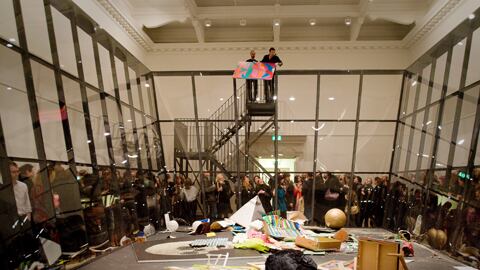Is some art so bad that it just deserves to die? Whatever your artistic inclinations, you’ll probably answer with a forceful yes. When it comes down to it, though, how do you decide what’s bad and what’s not quite so bad? And then what do you do with it all? These are a few of the questions Michael Landy asks in his exhibition “ Art Bin” at South London Gallery through March 14. “Art Bin” doesn’t just look at failed art, it revels in it.
Click Image To View Our Gallery Of Michael Landy’s “Art Bin”

“Seeing works being tossed off the top of a high platform, bouncing around and finally smashing, to great cheers from the crowd, was deeply satisfying,” says Charles Asprey, art collector, publisher of the arts journal Picpus, and Landy’s longtime friend and collaborator, describing what’s been going on in the gallery since the show opened on January 29.
Landy, 46, put out a call for failed artworks to fill his large transparent trash bin. During gallery hours, he is seated at a desk, ready to “appraise” works of art as they come through the door. Contributors whose offerings are accepted, are first asked to sign a release form allowing the artwork to be destroyed, and then invited to climb a set of steps and toss in their failed works.
Asprey and his wife, the sculptor Justine Asprey, contributed an early wax cast of her classical bust portrait of Landy himself. She considered the cast less successful than the final bust, which is displayed in the Aspreys’ home, so into the bin it went. The Aspreys aren’t the only ones to take pleasure in trashing art. Another contributor, John Lilley, called the experience of throwing four of his own failed drawings into the bin “enlightening” and “v. positive” on his Twitter feed.
Landy does set standards for what goes into his bin, and he’s rejected plenty of offerings so far. He says his decisions are entirely subjective. “I just have an instinct of what I like and don't like,” he explains. So far he has liked—or is it that he hasn’t liked?—works by artists Tracey Emin, Damien Hirst, Julian Opie, and Oona Grimes, as well as one from a man Landy usually sees behind the desk at his gym.
Best known for his 2001 work “Break Down,” Landy’s work tends to investigate ideas of consumption and waste in visceral ways. In “Break Down,” he catalogued and then meticulously destroyed every one of his 7,227 earthly possessions, which included his car, love letters, toothbrush, passport, and works by other artists. If “Break Down” raised powerful questions about consumption and identity, then “Art Bin” raises related questions about art as product—consumer product, waste product, and sometimes both at once.
“The art world has expanded so much over the past 20 years,” says Landy. “There are people all over the world making art and there are so many spaces to fill with art, so more and more art gets produced.” Charles Asprey adds that, “artists no longer get rid of work. In the past, editing used to happen in the studio. Now it all turns up in a gallery.” According to Asprey, it’s not just new works that could use some editing, it’s established ones, too. “We all know out of all the Andy Warhols there’s only 600 that ought to be saved, and that could be said for a lot of artists,” he says.
One of the things Landy does in “Art Bin” is give artists a chance to weed out the losers among their own works. Of his contribution, Gary Hume says, “I’ve been working on it for over ten years and it’s still not working. This seemed like a great opportunity to resolve it.” Asked why the piece had failed, Hume sighed and said, “Failure is the ponderous question. Maybe there’s not enough pain to go with the beauty, or not enough beauty to go with the pain, something like that.”
But what of the pieces that don’t make it into Michael Landy’s trash heap? “If you define what goes into the bin as detritus then the stuff that doesn't get in… well, I don’t know what that is,” says Landy. The worst kind of failure or a special kind of success? You decide.
Plus: Check out Art Beast, for galleries, interviews with artists, and photos from the hottest parties.
Sasha Watson has written about books, art, and travel for ARTnews, the Los Angeles Times, and DoubleX. She is the author of the young adult novel Vidalia in Paris.






